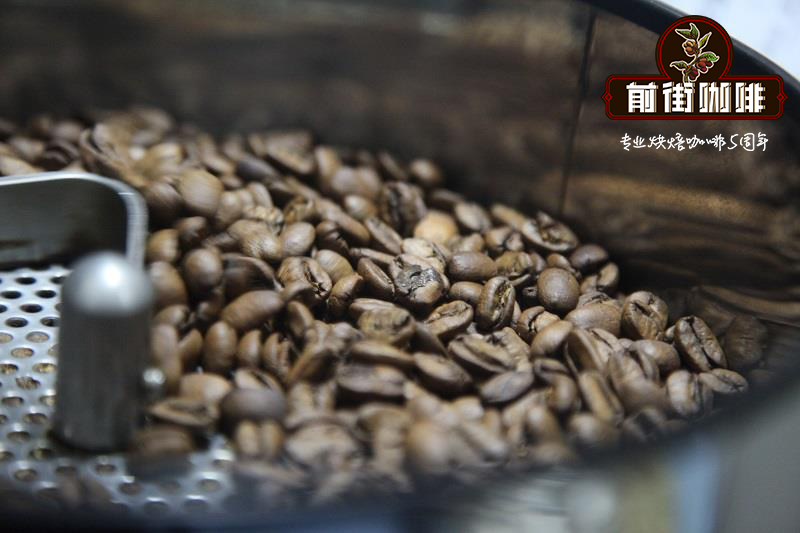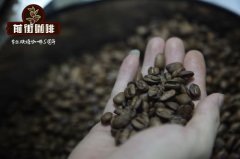What is coffee roasting? How does the coffee change after roasting? Trends in coffee roasting in various countries?

Professional coffee knowledge exchange more coffee bean information please follow the coffee workshop (Wechat official account cafe_style)
Basic concept
Raw coffee beans themselves do not have any aroma of coffee, only after fried, can you smell the strong aroma of coffee. So the roasting of coffee beans is the transformation process of the internal components of coffee beans, only after roasting to produce ingredients that can release the aroma of coffee, we can smell the aroma of coffee. But in the roasting process of coffee beans, the transformation of ingredients is very complex, after all, coffee beans are organic matter, so the transformation of this component is very complex, and the modern knowledge of organic chemistry can not fully understand.
However, the roasting of coffee beans directly determines the aroma of coffee beans. Coffee that is not roasted well cannot be obtained even if raw coffee beans are good. Very good coffee and ripe beans; as a result, of course, you can't make good coffee. Only with good coffee raw beans, after proper roasting, it is possible to process good coffee cooked beans, and it is also possible to provide a good prerequisite for making good coffee.
Fried coffee beans are roasted at high temperatures, or roasted, to create the coffee's unique color (similar to amber, depending on the degree of roasting), flavor and aroma. Frying turns the green (or yellowish) raw coffee beans into the familiar tea-brown coffee beans. High-quality fried roasting refers to the ingenious expression of the aroma, sour and bitter ingredients of raw coffee beans.
Technical Research
A series of chemical changes occur in the process of baking. After about 5-25 minutes of baking (depending on the temperature selected), the green coffee beans lose some humidity and turn yellow. In this process, the coffee beans will swell, changing from a strong, high-density raw bean to a low-density fluffy state. After this process, the coffee beans will about double in size and begin to show a light brown after stir-frying. After this stage is completed (after about 8 minutes of baking), the calories will be reduced. The color of the coffee soon changed to dark. When the preset baking depth is reached, cold air can be used to cool the coffee beans in order to stop the baking process.
Baking is roughly divided into shallow baking (Light), medium baking (Medium), urban baking (City) and deep baking (Deep). Light roasted coffee beans: will have a strong smell, very crisp, high acidity is the main flavor and slightly mellow. Medium-roasted coffee beans: have a strong mellow, but also retain a certain degree of acidity. City-baked coffee beans: the surface is dark brown, the acidity is replaced by slight bitterness, and most of the flavor has been destroyed. Deep-roasted coffee beans: dark brown in color and oily on the surface. For most coffee beans, the alcohol content increases significantly and the acidity decreases. In fact, roasting coffee is a way of processing food. The roasting of professional coffee is the personal expression of the roaster. The biggest problem when you first come into contact with professional coffee beans with different roasting degrees (SPCIAITYCOFFEE) is the name of the roasting degree. For example, CITY, FUIICITY, FRENCH, ESPRESSO, etc., all produce different baking colors because of the different baking machines and producing areas. In addition, some roasting levels are named after mixed coffee: for example, ESPRESSO is a coffee with a specific roasting degree for making ESPRESSO, and even if the color looks the same, it may have a completely different flavor. Therefore, the selection of the type of beans, baking temperature and baking method, and the length of baking time are the main factors that determine the final flavor.
Baking stage
The roasting method of professional coffee is usually divided into the following eight stages.
1. Very shallow baking (LIGHTRoast):
The degree of baking; very shallow baking, also known as shallow baking.
The lightest roasting degree of all roasting stages, the surface of the coffee beans is a light cinnamon color, its taste and aroma are insufficient, this state is almost undrinkable. It is generally used for testing and seldom for tasting.
2. Shallow baking (CINNAMONRoast):
Degree of baking; shallow baking, also known as cinnamon baking.
The general baking degree, showing cinnamon color on the appearance, the smell of green has been removed, the aroma is OK, and the acidity is strong, which is a common roasting degree of American coffee.
3. Micro baking (MEDIUMRoast):
Baking degree; moderate baking, also known as micro baking.
Medium baking heat and light baking are both American, in addition to sour taste, bitterness also appears, the taste is good. It has moderate aroma, acidity and mellowness, and is often used in the baking of mixed coffee.
4. Medium baking (HIGHRoast):
Baking degree; moderate micro-deep baking, also known as concentration baking.
Belongs to the moderate micro-deep baking, the baking degree is slightly stronger than the slight medium baking, the surface has appeared a little thick brown, the bitterness also becomes stronger. Coffee tastes sour and bitter, with good aroma and flavor, and is most often loved by people in Japan and Central Europe. (blue Mountain Coffee)
5. Medium and deep baking (CITYRoast):
Baking degree; medium-deep baking, also known as urban baking.
The most standard degree of roasting, bitterness and acidity are balanced and are often used in French coffee. (Brazil, Colombia)
6. Deep baking (FULL-CITYRoast):
Baking degree; micro-depth baking, also known as deep city baking.
The baking degree is slightly stronger than the medium depth, the color becomes quite dark, and the bitter taste is stronger than the sour taste. It belongs to the Central and South American baking method, which is very suitable for preparing all kinds of iced coffee.
7. Very Deep Baking (FrenchRoast):
Degree of baking; deep baking, also known as French baking.
Also known as French or European baking, belongs to deep baking, the color is thick brown with black, sour taste can not be felt, especially in Europe, France is the most popular, because the fat has infiltrated to the surface, with a unique flavor, very suitable for coffee Oulei, Viennese coffee.
8. Very Deep Baking (ItalianRoast):
Degree of baking; very deep baking, also known as Italian baking.
Also known as Italian baking, baking degree before carbonization, there is a scorched taste, mainly popular in Latin countries, suitable for fast coffee and cappuccino. Most of them are used in Espresso coffee series.
Coffee roasting
Baking depth meter
Baking depth appearance baking stage (the following temperature data are for reference only because of the different positions of temperature control points in different roasters)
Very shallow baking LIGHT
Light brown
Before and after the first explosion, 195 to 205 degrees
Shallow baking CINNAMON
Yellowish brown
The first explosion is over, about 205 degrees.
Medium baking / micro baking MEDIUM
Brown
About 205 to 215 degrees
Medium and deep baking / city baking, CITY
Reddish brown
About 215 to 225 degrees
City-wide baking, FULLCITY
Dark brown * dotted oil
About 225 degrees 230 degrees before the start of the second explosion
French baked French
Dark brown * oily on the surface
About 230 to 235 degrees
Italian baking is deep baking, Italian
ESPRESSO baking
Close to the black surface and greasy
Above 240 degrees
National tendency
Cities all over the world have their preferred baking tendency.
In Tokyo, micro-deep medium baking is more popular, but slowly it also tends to deep baking. As for Kansai, deep baking has been popular in the past.
New York, as its name suggests, generally prefers urban baking, but because the city is inhabited by different races of people, it also sells coffee beans with different roasting degrees, and the variety is also quite rich.
Vienna prefers deep baking. Even as the name suggests, the French prefer French baking, while Italians often use Italian baking.
However, in recent years, Italian baking (the most commonly used deep roasting in Brazil and Italy) has been widely used in Europe and the United States, and the coffee made by steam pressurizer is still popular.
Deep roasting of Ethiopian coffee beans would be a waste. Because that would lose the unique characteristics of this coffee. Black roasting of Yauco and Kona coffee beans is also bad, because you will lose the classical flavor you pursue when you buy it.
When some coffee beans are roasted black, new and interesting qualities will be derived. Mexican coffee beans produce an interesting sweetness when roasted in black.
Guatemala Antigua coffee beans seem to retain their sour and fruity flavor when they are deeply roasted, which is difficult for other coffees.
Sumatran coffee beans are usually full-grained, but are below medium acidity, lose acidity when roasted deeper, and easily turn into sugar paste.
Generally speaking, the darker the baking, the lower the quality. Deeper roasting means losing most of the flavor of the coffee beans.
Important Notice :
前街咖啡 FrontStreet Coffee has moved to new addredd:
FrontStreet Coffee Address: 315,Donghua East Road,GuangZhou
Tel:020 38364473
- Prev

The choice of ice cubes in cafes? What are the types of ice? What are the advantages and disadvantages of different types of ice?
Professional coffee knowledge exchange more coffee bean information Please pay attention to the coffee workshop (Wechat official account cafe_style) the seemingly simple ice cubes actually contain great knowledge. For drinks, ice is not only used as a way of cooling, its shape, size and even density will affect the drink. Although it has a cold temperature, it can miraculously finish with any drink.
- Next

What are the ways of roasting coffee? What are the characteristics of different baking?
If we want to take according to the use of coffee, there are many kinds of baking methods, among which there is no so-called the best or even the most superb baking method, if we want to distinguish, a more objective view should be according to the appearance of the raw beans on hand and the way we want to use them, baking in the most appropriate way. As mentioned above, among these many baking methods, we specifically pick out double baking.
Related
- Beginners will see the "Coffee pull flower" guide!
- What is the difference between ice blog purified milk and ordinary milk coffee?
- Why is the Philippines the largest producer of crops in Liberia?
- For coffee extraction, should the fine powder be retained?
- How does extracted espresso fill pressed powder? How much strength does it take to press the powder?
- How to make jasmine cold extract coffee? Is the jasmine + latte good?
- Will this little toy really make the coffee taste better? How does Lily Drip affect coffee extraction?
- Will the action of slapping the filter cup also affect coffee extraction?
- What's the difference between powder-to-water ratio and powder-to-liquid ratio?
- What is the Ethiopian local species? What does it have to do with Heirloom native species?

